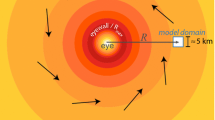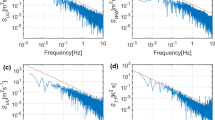Summary
This study examined ECMWF operational analyses of the outflow layer of two tropical cyclones (Allen, 1980; Elena, 1985) during their passage across the Atlantic and Caribbean. Wind fields and related derived quantities were compared to those from objective analyses of specialized data sets. Errors in center position and storm motion from the ECMWF analyses were also evaluated.
Analyses of wind and angular momentum flux in 1985, subsequent to upgrading of the operational model, were superior to those from 1980. High-resolution, uninitialized analyses from 1985, however, provided no advantages over lower resolution, initialized analyses for the same time period. For all ECMWF analyses, azimuthally averaged (mean) tangential velocity, and thus mean vorticity, were well represented. Mean radial velocity and mean divergence were poorly represented. Problems with the latter arose primarily due to underestimation of outflow, especially in the 1980 analyses. Azimuthaleddy fluxes of angular momentum in the ECMWF analyses quantitatively differed from but qualitatively resembled, the control analyses.
Vorticity maxima at 850 mb in the operational analyses most accurately defined the center position of the storms, with a mean error less than or equal to one grid point. In contrast, surface pressure minima failed to provide reliable estimates. Over open ocean and at early stages of storms, analysis quality was uneven, with occasional large position errors and widely varying locations of vorticity maxima in the vertical.
Nevertheless, in regions surrounded by even a few rawinsondes, such as the Caribbean or Gulf of Mexico, ECMWF analyses contained sufficient information to allow individual case studies of the tropical cyclone environment. In the same regions, estimates of the eddy flux convergence of angular momentum were found to be accurate enough to aid in operational hurricane intensity prediction. Enhancements in resolution and model initialization at ECMWF since 1985 should further improve operational analyses of the tropical cyclone environment.
Similar content being viewed by others
References
Achtemeier, G. L., 1989: Modification of a successive corrections objective analysis for improved derivative calculations.Mon. Wea. Rev.,117, 78–86.
Barnes, S. L., 1964: A technique for maximizing detalls in numerical weather map analysis.J. Appl. Meteor. 3, 396–409.
Bengtsson, L., Kanamitsu, M., Kallberg, P., Uppala, S., 1982: FGGE 4-dimensional data assimilation at ECMWF.Bull. Amer. Meteor. Soc.,63, 29–43.
Benjamin, S. G., Seaman, N. L., 1985: A simple scheme for objective analysis in curved flow.Mon. Wea. Rev.,113, 1184–1198.
Betts, A. K., Miller, M. J., 1986: A new convective scheme: Part II: Single column tests using GATE wave, Bomex, and arctic air-mass data sets.Quart. J. Roy. Meteor. Soc.,112, 693–710.
Bosart, L. F., Bartlo, J. A., 1991: Tropical storm formation in a baroclinic environment.Mon. Wea. Rev.,119, 1979–2013.
Carr, E. L., 1987: Objective data analysis conference.Bull. Amer. Meteor. Soc.,68, 481–485.
DeMaria, M., Baik, J.-J. Kaplan, J. 1992: Upper level eddy angular momentum fluxes and tropical cyclone intensity change.J. Atmos. Sci. (submitted).
Eliassen, A., 1952: Slow thermally or frictionally controlled meridional circulation in a circular vortex.Astrophys. Norv,5, 19–60.
Elsberry, R. L., Kirchoffer, P. J., 1988: Upper-level forcing of explosive cyclogenesis over the ocean based on operationally analyzed fields.Wea. For.,3, 205–216.
Frank, W. M., 1977: The structure and energetics of the tropical cyclone II: Dynamics and energetics.Mon. Wea. Rev.,105, 1136–1150.
Gray, W. M., 1979: Hurricanes: Their formation, structure, and likely role in the tropical circulation. In: Shaw, D. B. (ed.)Meteorology over the Tropical Oceans. Royal Meteorological Soc., 155–218.
Gray, W. M., 1988: Environmental influences on tropical cyclones.Austr. Meteor. Mag.,36, 127–138.
Heckley, W. A., Miller, M. J., Betts, A. K., 1987: An example of hurricane tracking and forecasting with global analysisforecasting system.Bull. Amer. Meteor. Soc.,68, 226–229.
Heckley, W. A., Kelly, G., Tiedtke, M., 1990: On the use of satellite-derived heating rates for data assimilation within the tropics.Mon. Wea. Rev.,118, 1743–1757.
Holland, G. J., 1983: Angular momentum transports in tropical cyclones.Quart. J. Roy. Meteor. Soc.,109, 187–210.
Holland, G. J., Merrill, R. T., 1984: On the dynamics of tropical cyclone structural changes.Quart. J. Roy. Meteor. Soc.,110, 723–745.
Hollingsworth, A., 1987: Objective analysis for numerical weather prediction. In: Matsuno, T. (ed.) Short and medium range numerical weather prediction.Meteor. Soc. Japan. Universal Academy Press, Tokyo, pp. 11–60.
Hollingsworth, A., Horn, J., Uppala, S., 1989: Verification of FGGE assimilations of the tropical wind field: The effect of model and data bias.Mon. Wea. Rev.,117, 1017–1038.
Kanamitsu, M., 1985: A study of the predictability of the ECMWF operational forecast model in the tropics.J. Meteor. Soc. Japan,63, 779–804.
Krishnamurti, T. N., 1989: Prediction of the life cycle of a super typhoon with a high resolution global model.Bull. Amer. Meteor. Soc.,70, 1218–1230.
Lau, K.-H., Lau, N.-C., 1990: Observed structure and propagation characteristics of tropical summertime synoptic scale disturbances.Mon. Wea. Rev.,118, 1888–1913.
Lawrence, M. B., Pelissier, J. M., 1981: Atlantic hurricane season of 1980.Mon. Wea. Rev.,109, 1567–1582.
Lee, C. S., Edson, R., Gray, W. M., 1989: Some large scale characteristics associated with tropical cyclone development in the North Indian Ocean during FGGE.Mon. Wea. Rev.,117, 407–426.
Lorenc, A. C., 1981: A global three-dimensional multivariate statistical interpolation scheme.Mon. Wea. Rev.,109, 701–721.
Manobianco, J., 1989: Explosive east coast cyclogenesis over the west-central north Atlantic Ocean: A composite study derived from ECMWF operational analyses.Mon. Wea. Rev.,117, 2365–2383.
McBride, J. L., Zehr, R., 1981: Observational analysis of tropical cyclone formation. Part II: Comparison of nondeveloping versus developing systems.J. Atmos. Sci.,38, 1132–1151.
Molinari, J., Vollaro, D., 1989a: External influences on hurricane intensity: Part I Outflow layer eddy angular momentum fluxes.J. Atmos. Sci. 46, 1093–1105.
Molinari, J., Vollaro, D., 1989b: Interaction of a hurricane with a baroclinic wave. Preprints, 18th Conf. on Hurricanes and Tropical Meteorology, Miami, 318–320. [A vailable from American Meteorological Society, 45 Beacon St., Boston, MA 02108.]
Molinari, J., Vollaro, D., 1990: External influences on hurricane intensity: Part II. Vertical structure and response of the hurricane vortex.J. Atmos. Sci.,47, 1902–1918.
Montgomery, M. T., Farrell, B. F., 1992: Tropical cyclone formation.J. Atmos. Sci.,49 (in press).
Ogura, Y., Chin, H. N., 1987: A case study of cross-equatorial twin vortices over the Pacific in the northern winter using FGGE data.J. Meteor. Soc. Japan. 65, 669–674.
Ooyama, K., 1987: Scale-controlled objective analysis.Mon. Wea. Rev.,115, 2479–2506.
Pauley, P. M., 1990. On the evolution of boundary errors in the Barnes objective analysis scheme.Mon. Wea. Rev.,118, 1203–1210.
Pauley, P. M., Wu, X., 1990: The theoretical, discrete, and actual response of the Barnes objective analysis scheme for one- and two-dimensional fields.Mon. Wea. Rev.,118, 1145–1163.
Pfeffer, R. L., Challa, M., 1981: A numerical study of the role of eddy fluxes of momentum in the development of Atlantic hurricanes.J. Atmos. Sci.,38, 2393–2398.
Puri, K., Gauntlett, D. J., 1987: Numerical weather prediction in the tropics. In: Matsuno, T. (ed.) Short and medium range numerical weather prediction.Meteor. Soc. Japan, Universal Academy Press, Tokyo, 605–632.
Puri, K., Lonnberg, P., 1991. Use of high-resolution structure functions and modified quality control in the analysis of tropical cyclones.Mon. Wea. Rev.,119, 1151–1167.
Puri, K., Miller, M. J., 1990: Sensitivity of ECMWF analysesforcasts of tropical cyclones to cumulus parameterization.Mon. Wea. Rev.,118, 1709–1741.
Reed, R. J., Hollingsworth, A., Heckley, W. A., Delsol F., 1988a: An evaluation of the performance of the ECMWF operational system in analyzing and forecasting easterly wave disturbances over Africa and the tropical Atlantic.Mon. Wea. Rev.,116, 824–865.
Reed, R. J., Simmons, A. J., Albright, M. D., Unden, P., 1988b: The role of latent heat release in explosive cyclogenesis: Three examples based on ECMWF operational forecasts.Wea. For.,3, 217–229.
Sanders, F., 1986: Explosive cyclogenesis in the west-central North Atlantic Ocean, 1981–84. Part I: Composite structure and mean behavior.Mon. Wea. Rev.,114, 1781–1794.
Skubis, S., Molinari, J., 1987: Angular momentum variation in a translating cyclone.Quart. J. Roy. Meteor. Soc.,113, 1041–1048.
Talagrand, O., Courtier, P., 1987: Variational assimilation of meteorological observations with the adjoint vorticity equation-Part I: Theory.Quart. J. Roy. Meteor. Soc.,113, 1311–1328.
Tiedtke, M., Heckley, W. A., Slingo, J., 1988: Tropical forecasting at ECMWF: The influence of physical parameterization on the mean structure of forecasts and analyses.Quart. J. Roy. Meteor. Soc.,114, 639–664.
Trenberth, K. E., Olson, J. G., 1988: An evaluation and intercomparison of global analyses from the National Meteorological Center and the European Centre for Medium Range Weather Forecasts.Bull. Amer. Meteor. Soc.,69, 1047–1057.
Unden, P., 1989: Tropical data assimilation and analysis of divergence.Mon. Wea. Rev.,117, 2495–2517.
Wergen, W., 1988: The diabatic ECMWF normal mode initialization scheme.Beitr. Phys. Atmos.,61, 274–302.
Willoughby, H. E., Clos, J. A., Shoreibah, M. G., 1982: Concentric eye walls, secondary wind maxima, and the evolution of a hurricane vortex.J. Atmos. Sci.,39, 395–411.
Author information
Authors and Affiliations
Additional information
With 11 Figures
Rights and permissions
About this article
Cite this article
Molinari, J., Vollaro, D. & Robasky, F. Use of ECMWF operational analyses for studies of the tropical cyclone environment. Meteorl. Atmos. Phys. 47, 127–144 (1992). https://doi.org/10.1007/BF01025613
Received:
Issue Date:
DOI: https://doi.org/10.1007/BF01025613




